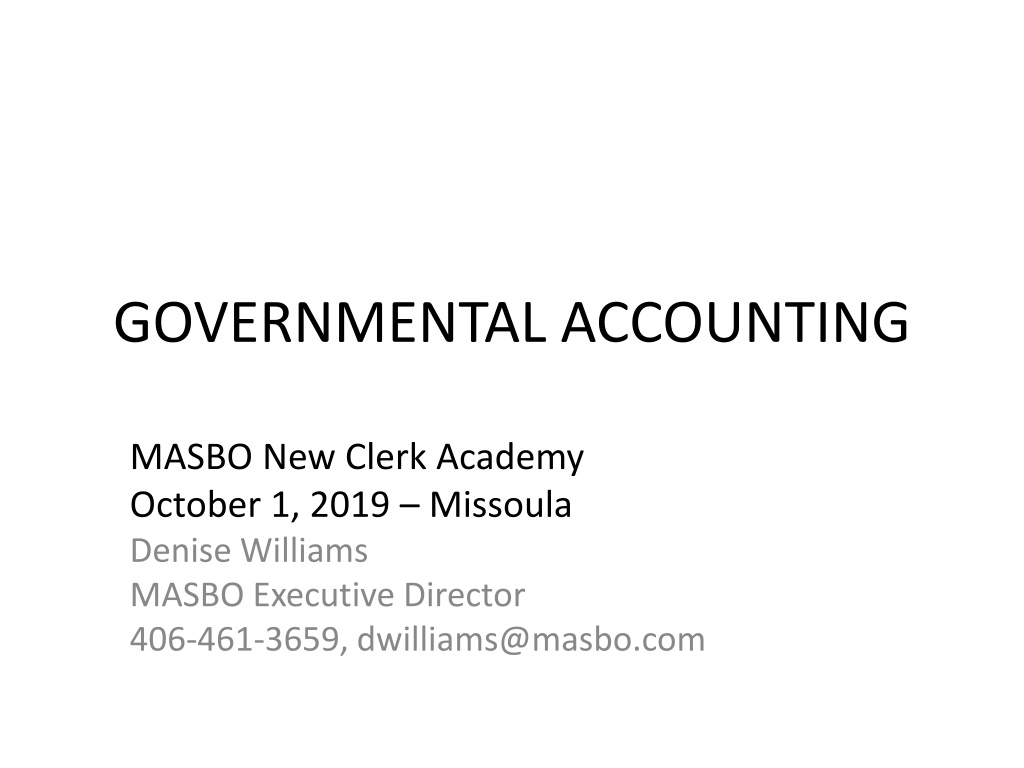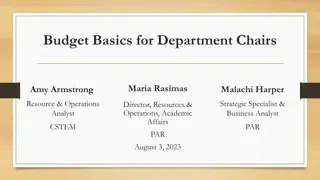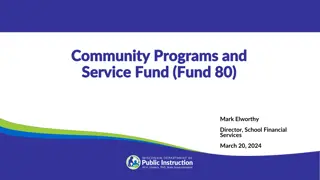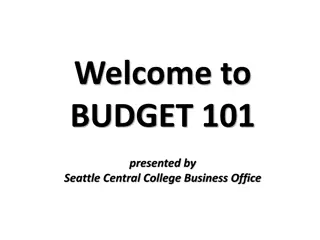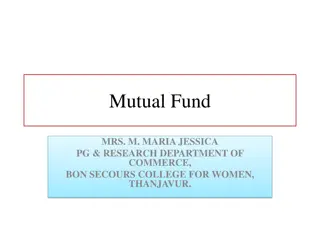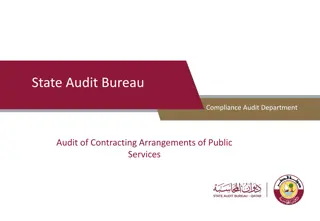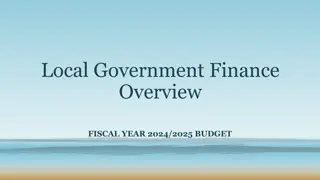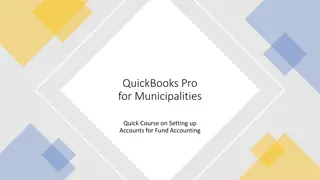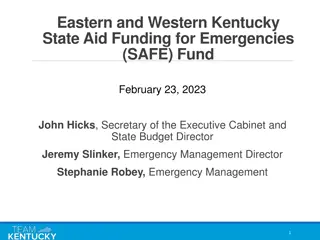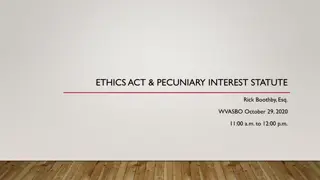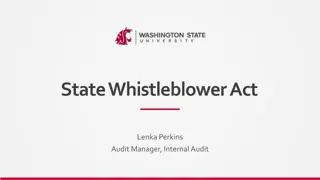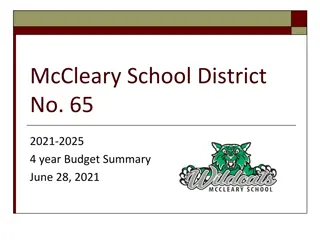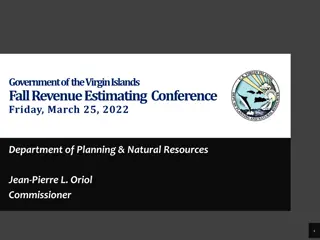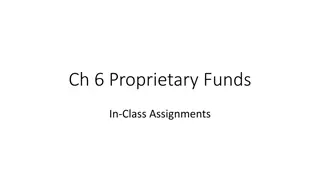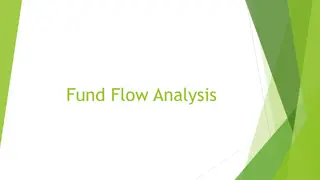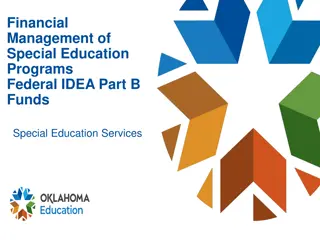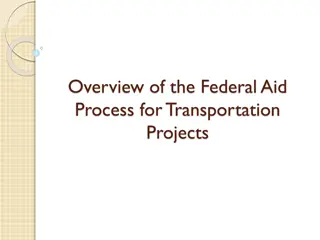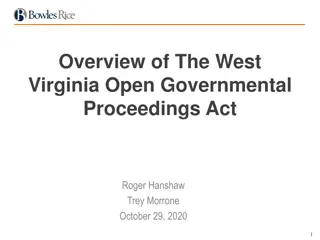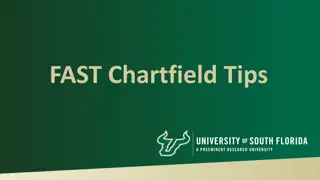Fund Accounting Overview and Types of Funds in Governmental Accounting
Fund accounting in governmental organizations involves segregating financial resources into self-balancing accounts to facilitate specific activities and objectives. This practice ensures compliance with regulations and restrictions, such as GAAP and state laws. Various types of funds, including governmental, proprietary, and fiduciary funds, serve distinct purposes like general operations, debt servicing, and capital projects. Assets, liabilities, and fund balances play vital roles in the accounting process, with revenues and expenditures tracking resources in and out during fiscal periods.
Download Presentation

Please find below an Image/Link to download the presentation.
The content on the website is provided AS IS for your information and personal use only. It may not be sold, licensed, or shared on other websites without obtaining consent from the author. Download presentation by click this link. If you encounter any issues during the download, it is possible that the publisher has removed the file from their server.
E N D
Presentation Transcript
GOVERNMENTAL ACCOUNTING MASBO New Clerk Academy October 1, 2019 Missoula Denise Williams MASBO Executive Director 406-461-3659, dwilliams@masbo.com
FUND ACCOUNTING What is a fund? self-balancing set of accounts Cash and other financial resources Liabilities Residual equities or fund balances segregated for the purpose of carrying on specific activities or attaining certain objectives in accordance with special regulations, restrictions, or limitations (GAAP, state law, GASB)
TYPES OF FUNDS Governmental General Special revenue Debt Service Capital Projects Permanent Proprietary Enterprise Internal Service Fiduciary - Trust - Custodial
FUND # FUND NAME FUND TYPE BUDDGETED FUNDS 01 General General 02 Transportation Special Revenue 11 Bus Depreciation Special Revenue 13 Tuition Special Revenue 14 Retirement Special Revenue 17 Adult Education Special Revenue 19 Non-Operating Special Revenue 28 Technology Special Revenue 29 Flexibility Special Revenue 50 Debt Service Debt Service 61 Building Reserve Capital Projects
FUND # FUND NAME FUND TYPE 12 School Foods Special Revenue NON-BUDDGETED FUNDS 15 Miscellaneous Programs Special Revenue 18 Traffic Education Special Revenue 20 Lease Rental Agreement Special Revenue 21 Compensated Absences Special Revenue 24 Metal Mines Tax Reserve Special Revenue 25 State Mining Impact Special Revenue 26 Impact Aid Special Revenue 27 Litigation Reserve Special Revenue 45 Permanent Endowment Permanent 60 Building Capital Projects 70-72 Enterprise Proprietary 73-79 Internal Service Proprietary 82 Interlocal Cooperative Fiduciary or General 81-85 Other Trust Funds Fiduciary
FUND ACCOUNTING Assets what is owned Cash and investments Taxes Receivable Due From Other Governments Liabilities what is owed Accounts payable Due to Other Governments Fund Balance residual balances of revenues and expenditures
FUND ACCOUNTING Revenue resources coming in during fiscal year Examples: state funding, property taxes Expenditures resources paid out during the fiscal year Salaries and benefits Supplies, utility bills, insurance, repairs Change in Fund Balance difference between revenue and expenditures for the fiscal year
FUND ACCOUNTING Balance Sheet (ongoing balances as of a given date) Assets Liabilities Fund Balance Revenues, Expenditures & Changes in Fund Balance (activity for a fiscal year) Revenues Expenditures Difference in revenues vs. expenditures is closed out to fund balance
FUND ACCOUNTING ACCOUNTING FORMULA Assets = Liabilities + Fund Balance Accounts with Debit Balances Assets Expenditures Accounts with Credit Balances Liabilities Fund Balance Revenues
Recording Transactions Account: an accounting record of increase and decreases in a specific asset, liability, revenue, expenditure or fund balance item In its simplest form an account consists of 3 items: TITLE Debit side Credit side
Recording Transactions Account Type Normal Balance Debit Credit Credit Credit Debit Effect of a Debit entry Increase Decrease Decrease Decrease Increase Effect of a Credit Entry Decrease Increase Increase Increase Decrease ASSET LIABILITY FUND BALANCE REVENUE EXPENDITURE
Recording Transactions CASH Debit side Credit side REVENUE Debit side Credit side
Recording Transactions CASH Debit side (increase) Credit side (decrease) REVENUE Debit side (decrease) Credit side (increase)
Recording Transactions REVENUE Debit side Credit side EXPENDITURE Debit side Credit side
Recording Transactions EXPENDITURE Debit side (increase) Credit side (decrease) REVENUE Debit side (decrease) Credit side (increase)
Recording Revenue Transaction 1 Received Direct State Aid from OPI: $200,000 CASH Debit side (increase) $200,000 REVENUE Credit side (increase) $200,000
Recording Expenditures EXPENDITURE Debit side (increase) Credit side (decrease) ACCOUNTS PAYABLE Debit side (increase) Credit side (decrease)
Recording Expenditures Transaction 2 Paid utility bill $5,000 ACCOUNTS PAYABLE Credit side (increase) $5,000 EXPENDITURE Debit side (increase) $5,000
Recording Expenditures Transaction 2 Paid utility bill $5,000 CASH Credit side (decrease) $5,000 ACCOUNTS PAYABLE Debit side (decrease) $5,000
Recording Transactions Journalizing the transactions Date of the transaction Accounts and amounts to be debited and credited Brief explanation of the transaction Each transaction must balance debits to credits (double entry accounting)
Journalizing the Transactions Transaction 1: Account Cash Revenue Debit $200,000 Credit $200,000 Received Direct State Aid from OPI
Journalizing the Transactions Transaction 2: Account Expenditure Accounts Payable Recorded utility bill claim $5,000 Debit $5,000 Credit $5,000
Journalizing the Transactions Transaction 2: Account Cash Accounts Payable Paid utility bill claim $5,000 Debit $5,000 Credit $5,000
Recording Transactions Transaction 1 Received Direct State Aid from OPI: $200,000 CASH $200,000 REVENUE $200,000
Recording Transactions Transaction 2 Recorded utility bill claim $5,000 ACCOUNTS PAYABLE $5,000 EXPENDITURE $5,000
Recording Transactions Transaction 2 Paid utility bill $5,000 CASH $5,000 ACCOUNTS PAYABLE $5,000
Recording Transactions Transaction 2 Recorded claim $5,000 ACCOUNTS PAYABLE $5,000 paid bill $5,000 recorded claim Paid utility bill $5,000
FUND ACCOUNTING Balance Sheet (balances as of a certain date) Assets Liabilities Fund Balance Revenues, Expenditures & Changes in Fund Balance (activity for a fiscal year) Revenues Expenditures Difference in revenues vs. expenditures is closed out to fund balance
Test Your Knowledge The Balance Sheet shows the balances of assets, liabilities and fund balance on a given date. a. True b. False
Test Your Knowledge The Statement of Revenues, Expenditures and Changes in Fund Balance show the balances of revenue and expenditure accounts for a period of time (fiscal year). a. True b. False
Test Your Knowledge The things a district owns, such as cash and receivables, are called: a. Fund Balance b. Revenues c. Assets d. Expenditures
Test Your Knowledge The things a district owes, such as accounts payable and deferred inflows, are called: a. Liabilities b. Revenues c. Assets d. Expenditures
Test Your Knowledge Which of the following are examples of governmental fund types: a. General b. Special Revenue c. Capital Projects d. All of the above are governmental type funds
Test Your Knowledge Which of the following are examples of special revenue funds used by Montana school districts: a. Retirement Fund b. Transportation Fund c. Flexibility Fund d. All of the above
Test Your Knowledge Which of the following are accounts that would be found on a Balance Sheet: a. Cash b. Liabilities c. Fund Balance d. All of the above
Test Your Knowledge Which of the following are accounts usually have a debit balance: a. Cash b. Liabilities c. Revenue d. Fund Balance
Test Your Knowledge Which of the following are accounts usually have a credit balance: a. Cash b. Liabilities c. Revenue d. b and c
Test Your Knowledge A transaction that increases Cash is recorded as a debit. a. True b. False
Test Your Knowledge A transaction that increases Revenue is recorded as a debit. a. True b. False
Test Your Knowledge A transaction that decreases Cash is recorded as a credit. a. True b. False
Test Your Knowledge A transaction that increases an Expenditure account is recorded as a debit. a. True b. False
